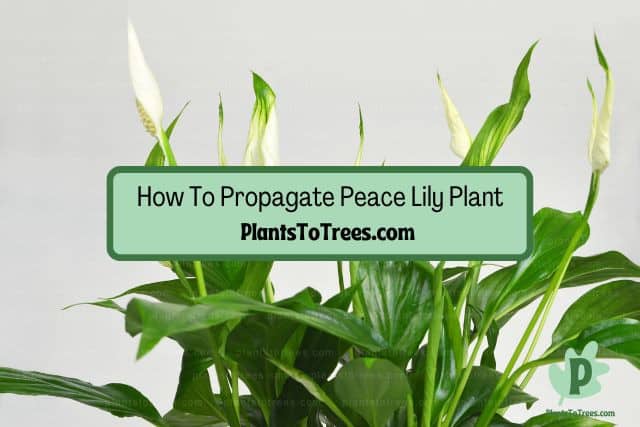The peace lily plant is one of the most commonly grown indoor houseplants. Its stunning deep green foliage and attractive creamy white flowers make a perfect addition to any indoor garden. What’s even better is that peace lily plants are relatively easy to care for, making them ideal for beginners.

A peace lily plant care guide helps ensure you provide this beloved houseplant with the right growing conditions. While peace lilies are relatively easy to care for, they do require a few conditions, such as warm temps and an abundance of bright indirect sunlight.
Following the peace lily plant care guide will improve your chances of success with growing this plant. Remember that even though it is a fairly easy-going houseplant, not providing the peace lily with the proper growing conditions will increase the chance of problems, such as diseases and insect infestations.
Other Names Of Peace Lily Plant
Peace lilies are known for their deep green, attractive foliage and long stunning blooms in shades of white. Most people know this plant simply as “peace lily”, but does it also have any other names that gardeners call it?
While peace lily is the most common name for this plant, it isn’t the only one. The peace lily is also known as spatha flower and white sails. The scientific name for this plant is Spathiphyllum wallisii.
Frost Tolerance And USDA Hardiness Zone Of Peace Lily Plant
Even though most people grow peace lilies indoors as a houseplant, there are some areas in the United States where they can be grown outdoors. Before you transplant your peace lily in the ground, let’s look at the plant’s frost tolerance, as well as which USDA plant hardiness zones that it can successfully grow in.
The frost tolerance and USDA hardiness zones for the peace lily are zones 11 and 12. The peace lily is a tropical plant that cannot handle cold temperatures well. In fact, frost can easily damage these popular houseplants.
Temperatures as low as 40 degrees Fahrenheit can cause damage to the plant’s stems, roots, and leaves. If left out in low temperatures for too long, the peace lily will start to rapidly decline and you could potentially kill your plant.
How Many Hours Of Sunlight Does a Peace Lily Plant Need?

Sunlight is vital for almost all plants, and peace lilies are no exception. Making sure your plant has the right amount of sunlight will help keep the peace lily healthy and happy.
Peace lilies grow best when they get 10 to 12 hours of daily sunlight, which is bright but indirect. They can also happily live under fluorescent lights as long as they get 16 to 18 hours of daily light.
Make sure to keep peace lilies out of direct light as this will result in leaf burn and stunted growth.
Peace Lily Plant Needs Direct Or Indirect Sunlight?

While sunlight is important for peace lilies, not all sunlight is created equally. Some sunlight can actually cause more harm than good, and even damage the plant’s foliage.
Peace lily plants need indirect sunlight. When grown in direct sunlight, the plant will experience burning and scorching of its leaves. Direct sunlight can also cause the plant to wilt and have stunted growth.
While you should avoid putting the peace lily in direct sunlight, it’s not the end of the world if you accidently leave the peace lily plant in direct sun. Simply move the plant to an area where it is out of direct sun. Keep in mind, however, that any foliage that has experienced leaf burn won’t recover, but new leaves won’t be affected.
Is Peace Lily Plant An Indoor Plant, Outdoor Plant Or Both?

Even though peace lilies are typically grown as a houseplant, some people may wonder if these stunning evergreens can also be grown outdoors.
Peace lilies are grown mostly as an indoor houseplant, although they can be grown outdoors in USDA hardiness zones 10 to 12. Even if you live outside of these zones, however, you can still move your peace lily plant outdoors when the weather is warm enough.
During the warm summer months, you can move your potted peace lily outside. Make sure that the plant is out of direct sunlight if you do take them outside, and remember to bring them in before the temperatures drop too low. Peace lilies should never be left outside when temperatures are 55 degrees Fahrenheit or below.
What Are The Indoor Lighting Requirements For A Peace Lily Plant?
Plants that are grown indoors need about the same type of lighting requirements as if they were to grow outdoors. That’s look at what type of lighting requirements your peace lily will need if you grow it inside your home.
Peace lily plants, when grown indoors, will need bright sunlight that is indirect for at least 10 to 12 hours every day. The best location for a peace lily is near an east-facing window, since it will give the plant bright morning sun.
Another option is next to a north-facing window. No matter where you place the plant, make sure it is out of direct sunlight. Placing the peace lily plant near a window that has a sheer curtain will help keep the plant out of direct sun while still giving it that vital bright light it needs.
What Are The Outdoor Lighting Requirements For A Peace Lily Plant?
If you live in USDA hardiness zones 10 to 12, you can grow your peace lilies outdoors. You will, however, have to provide them with the right lighting requirements to ensure they live a long life.
The best place to plant an outdoor peace lily is in a sheltered area where it will receive either morning sunlight or dappled light. Just make sure that the plant is out of direct sunlight and that the spot you choose will protect the plant from heavy rain and strong winds.
Peace lilies grow best outdoors in subtropical and tropical climates, such as what you can find in USDA hardiness zones 10 to 12. These locations have warm temperatures throughout the entire year, which is what the peace lily needs.
What Soil Requirements Does a Peace Lily Plant Need?

The soil that your peace lily is growing in can make or break the overall health of the plant. Poor soil conditions can lead to a wide array of issues, some of which can be fatal for the plant.
Peace lily plants need soil that is rich in organic matter, while also being loose and airy. They thrive in acidic soils with a pH level between 5.0 and 6.5. Avoid growing the plant in compact soil since this will lead to soggy roots, which in turn causes fungal diseases like root rot.
In their native habitat, peace lilies grow in soil that is extremely rich in decaying plant matter. This is because the tropical canopy is filled with a wide array of plants that litter the canopy floor. When these plants naturally decay, it puts vital nutrients into the soil which benefits other plants. Making sure your peace lily plant grows in soil rich in organic matter will help keep the plant healthy.
How Much Water Does the Peace Lily Plant Need?

Plants need water, but giving them too much hydration will spell disaster for the peace lily, resulting in fungal diseases. That is why it is important to ensure you are giving the plant the right amount of water.
Peace lilies need to be watered about once a week, though this time frame will vary depending on the age and size of the plant, temperature, and humidity level. When a peace lily needs watering, it will start to droop and sag a bit. When this occurs, it’s a sign to water the plant.
Make sure to keep track of how many days in between watering that this drooping occurs. This will give you a good general idea of how often the plant needs watering. When you have determined how many days the plant needs watered, you can give the peace lily a drink the day before the drooping typically occurs.
Is My Peace Lily Plant Overwatered, What Are The Symptoms?
Overwatering is the leading cause of fungal diseases in houseplants. Knowing the signs and symptoms of overwatering can help stop any potential problems before they are too far gone.
The symptoms of an overwatered peace lily include yellowing leaves, brown tips on the leaves, mushy brown roots, extreme drooping, and leaf spots. Other symptoms include fungal diseases, water blisters on the leaves and stems, an unpleasant odor coming from the plant, and insect infestation.
Once a plant has been severely overwatered, trying to get it healthy again can be a difficult task. This requires repotting the peace lily in a new pot with fresh soil. You may also have to prune off any dead or diseased roots as well. Even after all of this, the peace lily may never fully recover. That is why it is important to prevent overwatering your peace lily plant.
Is My Peace Lily Plant Underwatered, What Are The Symptoms?
Since we discussed overwatering, let’s look at underwatering. While underwatering isn’t nearly as harmful as overwatering, it can still cause issues for your peace lily plant.
The symptoms of an under-watered peace lily plant include wilting foliage that feels crispy or dry. If the plant is left under-watered for a prolonged period of time, it can develop brown or black splotches on the leaves, as well as wart-like blisters caused by leaf edema.
While you shouldn’t underwater your peace lily, it is much easier to get an under-watered plant healthy again than it is to treat a plant that has been severely overwatered.
How Much Fertilizer Does a Peace Lily Plant Need?

Even though the peace lily plant isn’t a heavy feeder, it can benefit from the occasional fertilizer. But not all fertilizers are ideal for this tropical houseplant. Adding the wrong fertilizer or too much fertilizer can actually have an adverse effect on the plant.
Peace lily plants need a water-soluble fertilizer that is of high quality. A balanced fertilizer made for houseplants, such as 20-20-20, works well for peace lilies. When applying the fertilizer, make sure to dilute it to ¼ or ½ its strength.
Applying the fertilizer in late winter will help encourage early spring and summer growth. In most cases, applying the diluted fertilizer every 6 weeks in late winter will help improve the growth of the plant.
Always read and follow the application instructions and warnings found on the fertilizer bottle. This will help prevent harm to you and your plants.
Peace Lily Plant Diseases To Be Aware Of

Peace lilies aren’t immune to diseases, but they also are not prone to them. That doesn’t mean they can’t get diseases, however. Knowing what diseases can affect this plant will help you better treat the problem if one arises.
The most common diseases that affect peace lilies are cylindrocladium root rot, dasheen mosaic virus, leaf blight, and pythium root rot. Thankfully, these diseases can typically be prevented with proper care and growing conditions.
Cylindrocladium root rot is caused by a fungal infection, which occurs when the peace lily has soggy roots. This could be due to poor soil drainage or overwatering the plant.
Dasheen mosaic virus is a viral disease that will result in a light green to yellowish pattern forming on the leaves. This pattern looks similar to a mosaic, hence the name. While this virus does alter the appearance of the plant’s foliage, it typically doesn’t cause harm to the peace lily or stunt its growth. Dasheen mosaic virus is typically spread by aphids and other sap-sucking pests. Unfortunately, there is no cure for the dasheen mosaic virus.
Leaf blight is a common plant disease that is caused by water mold, and typically spreads when water is splashed onto the plant. This disease thrives in environments with high levels of humidity and an abundance of moisture. Leaf blight will result in the centers and margins of the peace lily’s leaves developing brown and black spots. These spots may be mushy and wet if the environment is overly moist. If not, then they will be dead and dry.
In its early stages, you can typically stop the disease by repotting the peace lily in a sterilized pot with fresh potting soil. Remove any damaged foliage, and then treat the plant with fungicide. Leaf blight can be prevented by watering the plant at its base, which will help keep the leaves dry.
Pythium root rot is another disease that is caused by too much water and moisture. It will cause the infected plant’s leaves to yellow and wilt. Unfortunately, once symptoms have presented themselves, the roots of the infected peace lily have already started to turn mushy and black. If caught early enough, the peace lily can be repotted in fresh soil and treated with fungicide. In most cases, however, the plant will be too far gone to save. The best defense against this fungal disease is prevention, which includes ensuring the plant is growing in light soil that drains well and not overwatering it.
Are There Different Types Of Peace Lily Plants?
Peace lilies have been around for ages, providing gardeners with a fun and exciting plant to add to their indoor garden. While peace lilies are known for their stunning white blooms, you may wonder if there are any different types of peace lily plants available.
There are different types of peace lily plants, although the differences are mainly in their size. Peace lilies can be divided into 3 different categories: giant, medium-sized, and dwarf.
Despite what some think, the peace lily bloom is always white. The confusion comes from the anthurium plant. This plant looks similar to the peace lily and has blooms in shades of red and pink. They are, however, completely different plants.
How To Propagate Peace Lily Plant

For indoor gardeners, propagating their houseplants gives them the opportunity to increase the amount of plants they have. These extra plants can be sold or shared with family and friends. But how do you propagate a peace lily plant?
Propagating peace lily plants is done by division, which requires removing the original plant from its pot and dividing the roots and stems into smaller plants. Peace lilies do not propagate well via stem or leaf cutting, and trying to grow them from seed can be difficult.
One of the wonderful aspects of peace lilies is that they can be grown in both soil and water. In fact, many garden centers sell small peace lilies in vases filled with just water. Before you start the propagating process, decide what containers and growing medium you are going to grow your new plants in and then prepare them beforehand.
Tip the mother plant and its container to its side and slide the plant and its soil out of the pot. If it gives you resistance, tap the side of the pot until it slides out freely. Once the plant has been removed from the container.
Locate a crown section of the mother plant and carefully separate it from the mother plant with your hands. You can also use a sharp knife to cut away the section if you can’t separate it by hand. For the best results, choose a crown that has at least 2 leaves and attached roots. Continue separating crowns from the mother plant until you have the amount of plants you want.
Lay the divided crowns out on a flat surface covered with newspaper. Examine the leaves and roots, removing any dead or damaged parts that you find. The young plants are now ready to pot.
If you are growing the plants in soil, choose a container that is about 2 to 3 times the size of the young plant’s root ball. Fill the container with loose and moist potting soil and then plant the crowns as you normally would. If you are growing in water, fill a vase with distilled water and place the newly separated plants into the water-filled vase. Replace the water once a week.
We at Plants To Trees first published this article on August 21, 2022. Copyright protected.
Make sure to repot the mother plant, and then care for the young peace lilies in the same manner as the mother plant.
Is a Peace Lily Plant Toxic To Humans?
As with any type of plant, the toxicity of the peace lily plant should be considered before you bring it into your home. This is especially important if you have children.
All parts of the peace lily plant are toxic to humans, and can cause a wide array of symptoms if consumed. When eaten, the peace lily will cause a burning or tingling sensation on your lips, tongue, and mouth. They will then start to swell.
You may also experience contact dermatitis, as well as difficulty swallowing or breathing. If this occurs, immediately seek medical attention. The good news, however, is that this plant isn’t toxic to touch, and will only cause issues if eaten.
Is a Peace Lily Plant Toxic To Dogs?
Known for their loyalty, dogs can be both rewarding companions and stressful creatures. Especially when they get into things that they shouldn’t, such as houseplants.
The article owner is Plants To Trees dot Com and this article was first published on August 21, 2022.
Peace lilies are toxic to dogs, and can cause many of the same symptoms that a human will experience if ingested. Lips, mouth, and tongue irritation can occur, along with increased salivation, vomiting, and even difficulty breathing.
In most cases, thankfully, consuming peace lilies isn’t fatal to your pooch. If, however, your dog has consumed an abundance of the plant, it’s best to seek emergency medical treatment. Furthermore, if your dog starts having difficulty breathing, immediately take them to the emergency vet. If they are breathing fine but showing other symptoms of peace lily poisoning, reach out to poison control. They can confirm whether or not you should take your dog to the emergency vet.
Is a Peace Lily Plant Toxic To Cats?
Despite their cute little faces, cats are mischievous animals that have a way of getting into things that are hard to reach for other pets. And since many houseplants are extremely toxic to cats, it’s vital to know the level of toxicity that any plant has before you decide to grow it indoors.
All parts of the peace lily plant are toxic to cats, including the stems, leaves, and blooms. As with humans and dogs, cats will experience burning in their lips, mouth, and tongue, as well as excessive drooling, possible swelling of lips, mouth, and tongue, and difficulty breathing.
Since the peace lily is considered mildly toxic to cats, your furry friend should be fine after the symptoms pass, but you should consider reaching out to your veterinarian or poison control to get their expert opinion when your cat eats anything that can pose a risk to their health.
Most cat parents are aware just how deadly lilies and plants in the lily family can be. While the peace lily does pose a threat to your kitty, the toxicity of them isn’t as dangerous as true lily plants. That doesn’t mean you should allow your feline to nibble or play with the peace lily. It just means they shouldn’t have any long-term effects if they consume a little of this plant.
Related Articles
Fiddle Leaf Fig Plant Care Guide
PlantsToTrees.com is the owner of this article and we first published this on August 21, 2022.
